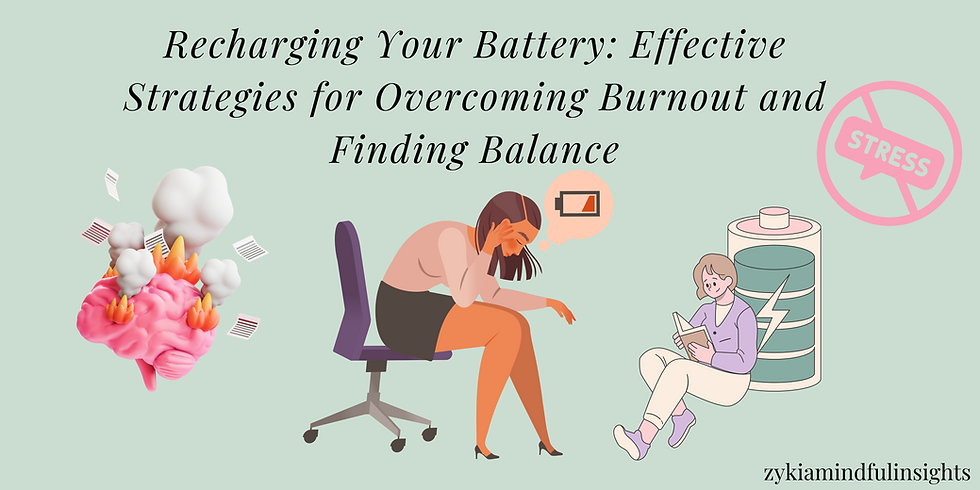Effective Strategies for Overcoming Social Isolation and Building Community Connections
- Zykia Hannah

- Mar 4, 2024
- 7 min read

Overcoming social isolation involves engaging in activities and behaviors that help build connections and foster a sense of community. Some strategies for doing this include:
Joining clubs or groups: Joining a local club or group based on your interests can help you meet like-minded people and build new friendships.
Volunteering: Volunteering for a cause you care about can help you meet new people while also making a positive impact in your community.
Participating in community events: Participating in community events, such as festivals or fundraisers, can provide opportunities to meet new people and build connections with others in your area.
Attending social gatherings: Attending social gatherings, such as parties or dinners, can provide opportunities to meet new people and build connections with others.
Getting involved in your community: Getting involved in your community, such as by attending local government meetings or joining a neighborhood association, can help you build connections with others who share your interests and values.
Using technology: Using technology, such as social media or online forums, can help you connect with others who share your interests and values.
Reaching out to friends and family: Reaching out to friends and family members can help you maintain and strengthen your existing relationships.
Seeking professional help: If you are struggling with social isolation, seeking professional help from a therapist or counselor can provide support and guidance.
Overall, building connections and fostering a sense of community involves actively engaging with others and participating in activities that align with your interests and values.
What is the difference between loneliness and social isolation?
Loneliness and social isolation are related concepts, but they have distinct differences:
Loneliness refers to the subjective feeling of being disconnected from others, despite being surrounded by people. It is a negative emotional state that can be experienced even when an individual is physically in the presence of others.
Social isolation, on the other hand, refers to a lack of social contact or interaction with others. It is an objective measure of the quantity and quality of an individual's social connections. Social isolation can occur even when an individual does not feel lonely, as they may be satisfied with their level of social interaction or feel fulfilled by other aspects of their life.
In summary, loneliness is a subjective emotional state, while social isolation is an objective measure of an individual's social connections. While they often occur together, they can also be experienced independently of each other.
How can feeling lonely or being isolated affect older adults health?
Feeling lonely or being socially isolated can have significant effects on the health of older adults, both physically and mentally. Some of these effects include:
Mental Health: Loneliness and social isolation are risk factors for depression, anxiety, and cognitive decline in older adults. They can also lead to feelings of hopelessness, worthlessness, and a loss of purpose.
Physical Health: Studies have shown that older adults who feel lonely or are socially isolated are at a higher risk of developing chronic health conditions, such as heart disease, high blood pressure, obesity, and diabetes. They may also experience increased levels of inflammation and have a weakened immune system.
Mortality: Research has found that loneliness and social isolation are associated with an increased risk of premature death in older adults. This risk is comparable to that of smoking and obesity.
Quality of Life: Feeling lonely or being socially isolated can negatively impact an older adult's overall quality of life, including their ability to perform daily activities, their independence, and their overall well-being.
It is important to recognize the impact that loneliness and social isolation can have on older adults' health and well-being. Encouraging and facilitating social connections and providing support to those who are experiencing loneliness or social isolation are important steps in addressing this issue.
Recognize the Issue and Its Impact
Many individuals, particularly older adults, experience social isolation, which can have detrimental effects on their mental and physical health. It's essential to recognize the issue and its impact on individuals' lives and health.
Seek Support and Social Opportunities
One effective way to overcome social isolation is by seeking support and participating in social opportunities. This can include joining clubs or groups, volunteering for a cause you care about, attending community events, and participating in social gatherings.
Utilize Technology
In today's digital age, technology can be a valuable tool for overcoming social isolation. Platforms like social media, online forums, and video calls can help individuals connect with others and build a sense of community, even if they are physically distant.
Develop Personal Connections
Building personal connections with others is essential for overcoming social isolation. This can involve reaching out to friends and family, getting involved in your community, and actively participating in social activities that align with your interests and values.
Encourage Community Involvement
Finally, encouraging community involvement and fostering a sense of community can be an effective way to overcome social isolation. This can include participating in local government meetings, joining a neighborhood association, and engaging with others who share your interests and values.
In summary, overcoming social isolation involves recognizing the issue and its impact, seeking support and social opportunities, utilizing technology, developing personal connections, and encouraging community involvement. By actively engaging in these strategies, individuals can build connections, foster a sense of community, and ultimately overcome social isolation.
Certain circumstances can heighten the risk of feeling lonely or socially isolated. This can occur when someone unexpectedly finds themselves separated from friends or family due to illness, loss of mobility, or worsening vision or hearing.
Additionally, significant life changes such as losing a partner, moving to a new place, or retiring can increase feelings of loneliness and isolation.
Other risk factors for loneliness and social isolation include living alone, having limited mobility or access to transportation, facing financial difficulties, being a caregiver, experiencing psychological or cognitive challenges, or lacking strong social support networks. Moreover, living in rural or unsafe areas, facing language barriers, experiencing discrimination based on age, race, ethnicity, sexual orientation, or gender identity, and not engaging in meaningful activities or feeling a sense of purpose can all contribute to a heightened sense of loneliness and social isolation.
People with hearing loss may face unique challenges in maintaining social connections, as communication with friends and family can become more difficult. This can lead to reduced interaction with others, increased social isolation, and a higher risk of experiencing loneliness.
External factors about overcoming social isolation: strategies for building connection and community
Social isolation can arise from external factors, including life transitions, health challenges, geographical location, and societal norms. Overcoming social isolation often requires a multi-faceted approach that addresses these external factors. Here are some strategies:
Life Transitions: Life changes such as retirement, relocation, or the loss of a loved one can contribute to social isolation. Encouraging individuals to seek new activities, clubs, or social groups in their new stage of life can help them rebuild their social networks.
Health Challenges: Health issues can limit mobility or cause discomfort in social situations. Creating inclusive environments and adapting activities to accommodate individuals with health challenges can help them stay engaged and connected.
Geographical Location: Living in rural or hard-to-reach areas can limit access to social activities. Utilizing technology for virtual connections, arranging transportation, or hosting events closer to these areas can help individuals overcome geographical barriers.
Societal Norms: Societal norms and cultural practices can influence social interaction. Encouraging open-mindedness and diversity in community activities can help create inclusive spaces for everyone to participate.
In conclusion, understanding and addressing external factors such as life transitions, health challenges, geographical location, and societal norms are essential in overcoming social isolation and building connections and community. By offering diverse and inclusive opportunities for engagement, individuals can find ways to participate and connect, regardless of their external circumstances.
Internal factors about overcoming social isolation: strategies for building connection and community
Feeling isolated can arise from various factors, and each person's experience is unique. Here are some possible causes of social isolation and strategies to overcome them:
Shyness: Shyness can make it challenging to approach others or attend social events, leading to self-isolation. Pushing past discomfort and gradually exposing yourself to social situations can help you develop confidence and build connections.
Introversion: Introverts may prioritize solitude to recharge, but excessive isolation can lead to loneliness. Balancing alone time with social interaction, even in small doses, can help introverts stay connected.
Low self-esteem: Negative self-perception and anticipating rejection can discourage reaching out to others. Working on building self-esteem through self-care and positive affirmations can make social interactions less intimidating.
Communication skills: Difficulty initiating or maintaining conversations can hinder forming new friendships. Practicing active listening, asking open-ended questions, and joining social groups with shared interests can help improve communication skills.
Social withdrawal due to health conditions: Conditions such as depression, anxiety, or hearing loss can lead to withdrawal from social situations. Seeking support from mental health professionals or seeking treatment for health conditions can help manage symptoms and improve social interaction.
Every individual's experience of loneliness is different, and there's no one-size-fits-all solution. However, taking proactive steps, such as seeking support, trying new coping strategies, and gradually expanding social interactions, can help combat loneliness and foster a sense of connection.
Overcoming loneliness and isolation: Expand your social network
When looking to forge new connections and alleviate feelings of isolation, consider these avenues:
Clubs and Groups: Join local clubs or groups that align with your interests. Whether it's outdoor activities, book discussions, or crafting, shared interests can foster meaningful connections.
Educational Opportunities: Enroll in a class at a community college to expand your skill set and meet others. Courses that promote interaction, like foreign languages or dance, can be especially conducive to forming friendships.
Attend Community Events: Concerts, art exhibitions, or sports matches provide a platform to meet individuals with similar interests. This is particularly useful if committing to regular activities is difficult.
Engaging in volunteer work not only enables you to contribute to a cause you're passionate about but also presents opportunities to connect with new individuals. As you contribute to the community, your sense of self-worth may increase, which could encourage you to initiate conversations with others more readily.
Turning acquaintances into friends
Transforming acquaintances into friends involves a deliberate approach that fosters genuine connections. Here are some strategies:
Extend Invitations: Suggest casual activities like a walk or lunch with a coworker, allowing for relaxed conversations and a deeper understanding of each other.
Focus on Common Interests: Shared hobbies or interests can create a foundation for stronger connections. Encourage acquaintances to join local groups or attend events together.
Offer Help: Volunteering assistance, like lending a hand during a move or asking for help with a project, can forge closer bonds with acquaintances.
Reconnect with Old Friends: Reach out to former schoolmates or colleagues via social media. Nostalgic conversations about shared experiences can rekindle friendships.
Patience is Key: Building friendships takes time. Avoid being overly eager, as this may deter potential friends. Allow relationships to develop naturally.
Tip for young adults: Quality over quantity
It's important not to confuse the number of relationships with their quality. A vast online network of acquaintances won't necessarily ease loneliness. A smaller circle of close, in-person friends typically offers better social support. This realization is often more common among older adults. They tend to maintain smaller social circles, which are often more meaningful and less overwhelming than those of younger individuals.
🫧Quote of the day:
“Learn to value yourself, which means: fight for your happiness.” ― Ayn Rand




Comments